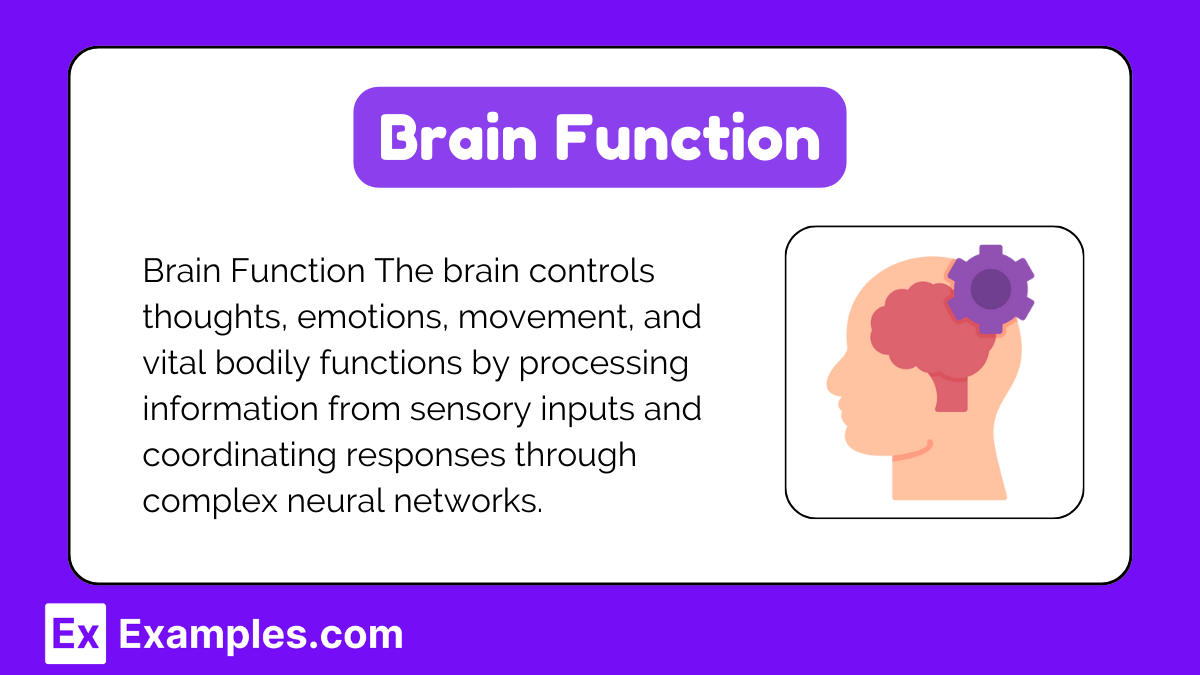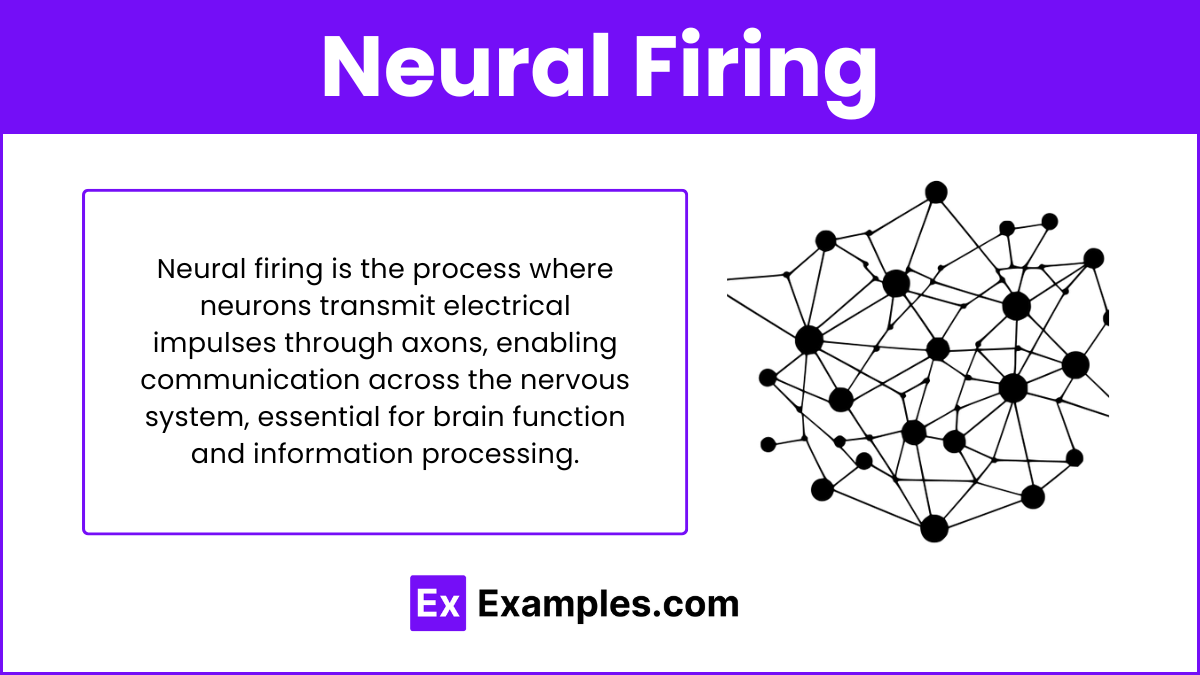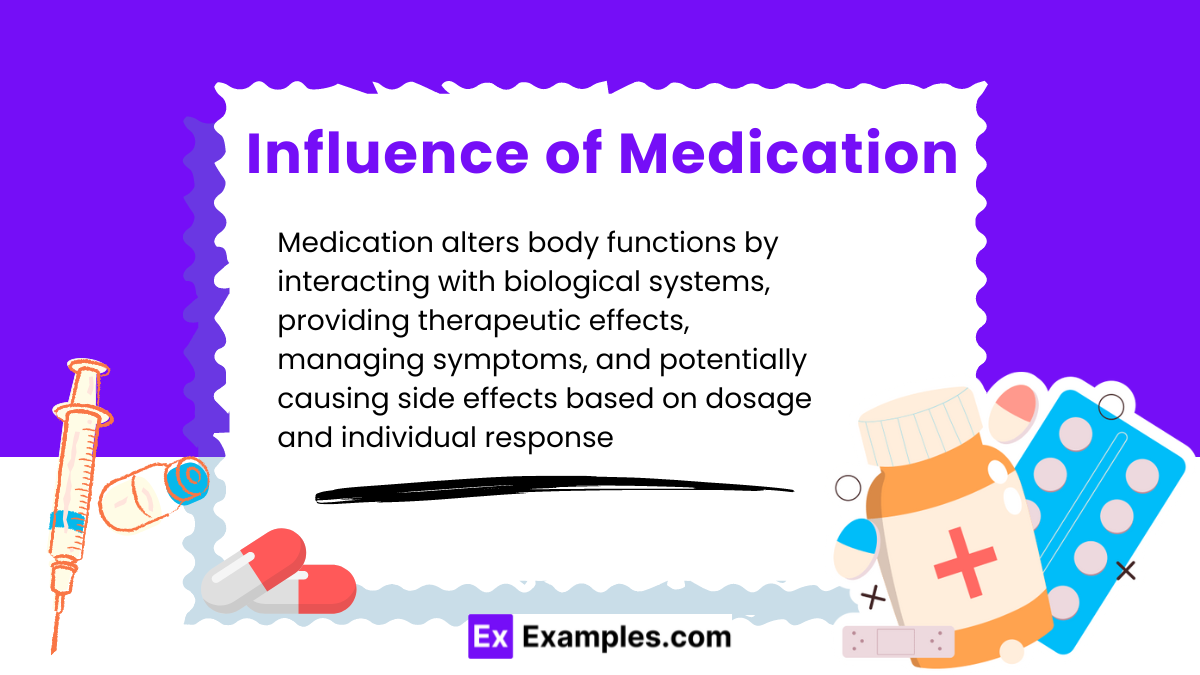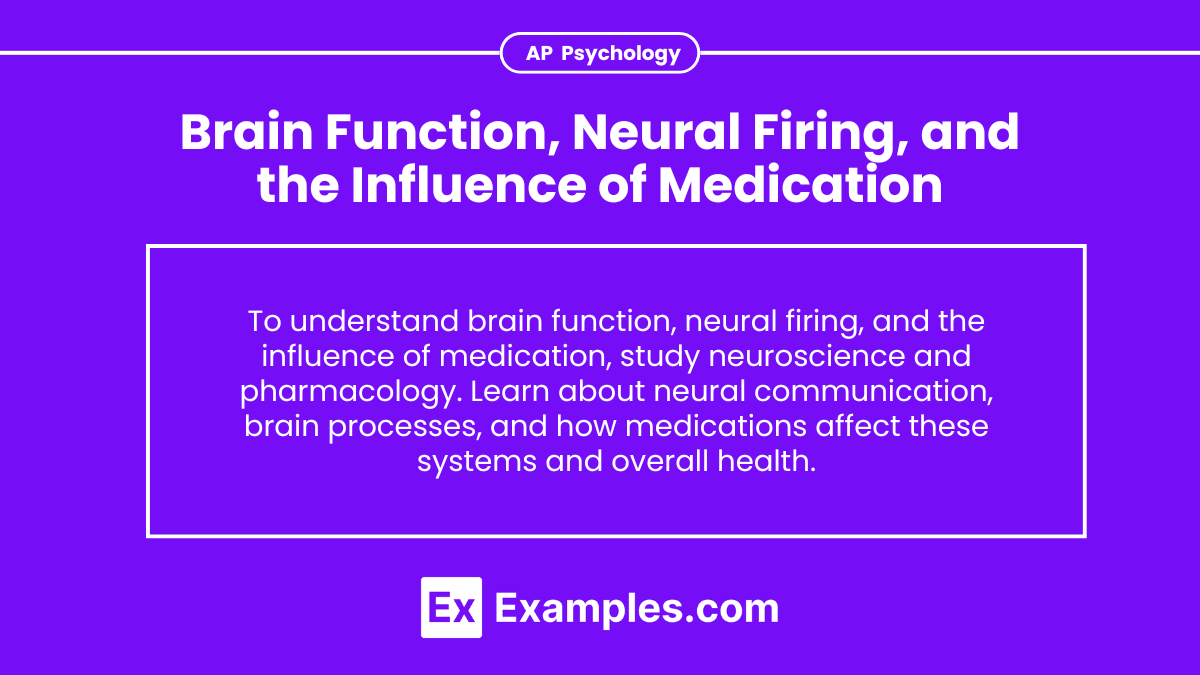Understanding brain function, neural firing, and the influence of medication is fundamental in AP Psychology. The brain controls thoughts, emotions, and behaviors through complex networks of neurons that communicate via electrical impulses and chemical signals. Neural firing, or action potentials, enables this communication. Medications can significantly affect these processes by altering neurotransmitter levels or receptor activity. These topics are crucial for grasping the biological underpinnings of psychological phenomena, providing a basis for exploring mental health and treatment strategies.
Learning Objectives
For the AP Psychology exam, understand brain function, neural firing, and the influence of medication. Learn the key brain structures and their roles, how neurons communicate through electrical impulses and neurotransmitters, and how medications can affect neural activity and behavior. Focus on the impact of drugs on synaptic transmission and their therapeutic uses and side effects. This knowledge will help explain how brain activity influences behavior and how medications can modify these processes
Brain Function

The human brain, a marvel of biological engineering, is the command center for the entire body. It orchestrates a symphony of functions that range from basic survival processes to complex thought and emotions. Understanding brain function involves exploring its structure, the various regions and their roles, and how they communicate through an intricate network of neurons.
Structure of the Brain
The brain is divided into three main parts: the cerebrum, cerebellum, and brainstem. Each part has distinct functions that contribute to the overall operation of the brain.
1. Cerebrum
The cerebrum is the largest part of the brain and is responsible for most of the brain’s complex activities. It is divided into two hemispheres (left and right) and further into four lobes:
- Frontal Lobe: Associated with reasoning, planning, parts of speech, movement, emotions, and problem-solving.
- Parietal Lobe: Manages perception of stimuli such as touch, pressure, temperature, and pain.
- Occipital Lobe: Primarily responsible for vision.
- Temporal Lobe: Involved in auditory perception, memory, and speech.
2. Cerebellum
Located under the cerebrum, the cerebellum coordinates voluntary movements such as posture, balance, coordination, and speech, resulting in smooth and balanced muscular activity.
3. Brainstem
The brainstem connects the cerebrum with the spinal cord and controls vital life functions such as breathing, heart rate, and blood pressure. It includes the midbrain, pons, and medulla oblongata.
Neurons: The Building Blocks
Neurons are the primary cells responsible for brain function. They transmit information through electrical and chemical signals. A neuron consists of three main parts:
- Cell Body (Soma): Contains the nucleus and is the metabolic center.
- Axon: A long, slender projection that conducts electrical impulses away from the cell body.
- Dendrites: Branch-like structures that receive messages from other neurons.
Synapses and Neurotransmitters
Neurons communicate at junctions called synapses, where the axon terminal of one neuron meets the dendrite of another. The communication occurs via neurotransmitters, which are chemicals that transmit signals across the synapse. Key neurotransmitters include:
- Dopamine: Involved in reward, motivation, and motor control.
- Serotonin: Regulates mood, appetite, and sleep.
- Acetylcholine: Important for learning and memory.
- GABA (Gamma-Aminobutyric Acid): The primary inhibitory neurotransmitter, which reduces neuronal excitability.
Brain Function and Regions
Different regions of the brain specialize in various functions:
- Cerebral Cortex: The outer layer of the cerebrum involved in complex brain functions such as thought, perception, and memory.
- Limbic System: Includes structures like the hippocampus and amygdala, crucial for emotion, behavior, and long-term memory.
- Basal Ganglia: Involved in movement regulation and procedural learning.
- Thalamus: Acts as a relay station for sensory and motor signals to the cerebral cortex.
- Hypothalamus: Regulates autonomic functions such as hunger, thirst, and body temperature.
Brain Plasticity
The brain’s remarkable ability to change and adapt in response to experience is known as neuroplasticity. This includes the formation of new neural connections and the reorganization of existing ones, essential for learning, memory, and recovery from brain injuries.
Common Brain Disorders
Understanding brain function also involves recognizing disorders that can affect it:
- Alzheimer’s Disease: A progressive neurodegenerative disorder that impairs memory and cognitive function.
- Parkinson’s Disease: A disorder of the central nervous system affecting movement, often including tremors.
- Stroke: Occurs when the blood supply to part of the brain is interrupted, causing brain cells to die.
- Epilepsy: Characterized by recurrent seizures due to abnormal electrical activity in the brain.
Neural Firing

Neural firing, also known as an action potential, is the process by which neurons communicate with each other. This communication is crucial for everything from basic bodily functions to complex cognitive processes. Understanding neural firing involves exploring the mechanisms that generate and propagate action potentials, the role of ion channels, and how synapses facilitate neuron-to-neuron communication.
Resting Potential
Neurons maintain a resting potential, a difference in electrical charge across their membrane, typically around -70 millivolts (mV). This state is achieved through the distribution of ions, mainly sodium (Na+), potassium (K+), chloride (Cl-), and various negatively charged proteins.
- Sodium-Potassium Pump: Actively transports 3 Na+ ions out of the neuron and 2 K+ ions into the neuron, maintaining the resting potential.
Generation of Action Potential
An action potential is triggered when the neuron’s membrane potential becomes less negative, reaching a threshold, usually around -55 mV. This process occurs in several steps:
1. Depolarization
- Stimulus: A stimulus causes the opening of voltage-gated sodium channels.
- Na+ Influx: Na+ ions rush into the cell, causing the membrane potential to become more positive (depolarization).
2. Repolarization
- Peak Voltage: When the membrane potential reaches approximately +30 mV, the sodium channels close.
- K+ Efflux: Voltage-gated potassium channels open, allowing K+ ions to exit the cell, returning the membrane potential to a more negative state (repolarization).
3. Hyperpolarization
- Overshoot: The efflux of K+ ions often causes the membrane potential to become more negative than the resting potential (hyperpolarization).
- Restoration: The sodium-potassium pump and leak channels restore the resting potential.
Factors Influencing Neural Firing
- Ion Channel Function: Mutations or malfunctions in ion channels can affect neural firing.
- Myelination: Diseases like multiple sclerosis that damage the myelin sheath slow down or block action potentials.
- Synaptic Strength: Changes in the number or sensitivity of receptors can enhance or diminish synaptic transmission.
Influence of Medication

Medication plays a crucial role in modern healthcare, providing relief, managing symptoms, and curing illnesses. Understanding the influence of medication on the body is essential for optimizing treatment outcomes and minimizing adverse effects.
Types of Medications
- Analgesics: Relieve pain (e.g., aspirin, ibuprofen).
- Antibiotics: Treat bacterial infections (e.g., amoxicillin, ciprofloxacin).
- Antidepressants: Manage depression and anxiety (e.g., fluoxetine, sertraline).
- Antihistamines: Alleviate allergic reactions (e.g., loratadine, cetirizine).
- Antihypertensives: Lower high blood pressure (e.g., lisinopril, amlodipine).
- Antipyretics: Reduce fever (e.g., acetaminophen, ibuprofen).
- Antivirals: Combat viral infections (e.g., oseltamivir, acyclovir).
How Medications Work
- Receptor Binding: Many drugs work by binding to specific receptors on cells, initiating a physiological response. For instance, beta-blockers bind to beta-adrenergic receptors to reduce heart rate and blood pressure.
- Enzyme Inhibition: Some medications inhibit the activity of enzymes. For example, statins lower cholesterol levels by inhibiting the enzyme HMG-CoA reductase.
- Ion Channel Modulation: Drugs can also influence ion channels, which are crucial for nerve signal transmission. Antiepileptic drugs, like phenytoin, modulate sodium channels to prevent seizures.
- Hormone Replacement: Hormone replacement therapies, such as insulin for diabetes, supply hormones that the body cannot produce in sufficient quantities.
Factors Affecting Medication Influence
- Dosage: The amount of medication administered significantly impacts its effectiveness and risk of side effects.
- Route of Administration: Oral, intravenous, topical, and other routes affect the onset and intensity of drug effects.
- Age and Weight: These can influence metabolism and the body’s response to medications.
- Genetic Factors: Genetic variations can affect drug metabolism and efficacy.
- Drug Interactions: Concurrent use of multiple medications can lead to interactions that enhance or reduce the effects of one or more drugs.
- Health Conditions: Chronic conditions like liver or kidney disease can alter drug metabolism and excretion.


